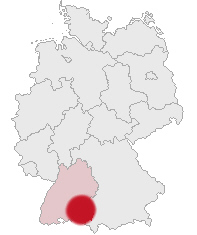 Welcome to Upper Swabia
Welcome to Upper Swabia
Upper Swabia is a region in the very south of Germany, comprising the southeast of the state of Baden-Württemberg, between Lake Constance and the Danube. It is internationally known for its rich historic heritage, including medieval towns such as Ulm, Ravensburg, Biberach, and Überlingen, as well as numerous Baroque monasteries like Weingarten, Salem, Zwiefalten, or Ochsenhausen. Churches and chapels dominate the mainly rural landscape, and nearly every village has a church lavishly decorated with sculptures, stucco and frescoes. Aptly enough, a popular touristic theme route leading through the region is called the Upper Swabian Baroque Route.
Upper Swabia is home to many fine pipe organs, including monumental works by Joseph Gabler, Johann Nepomuk Holzhey, and the Schmahl family, but also lots of lesser-known historic organs from the 17th to the early 20th century. Some of these organs are regularly used in high-profile concerts and have been immortalized in books and CDs. Many others are played every Sunday in Mass and serve their purpose very well. However, a larger audience of music lovers and organ enthusiasts has yet to discover them.
Society „Historic Organs in Upper Swabia“
The now decfunct society „Historische Orgeln in Oberschwaben e. V.“ used to
- promote research on Upper Swabian organs, their history, and their builders
- publish research results in books, academic journals, and the regional press
- hold lectures and exhibitions to help protect and conserve historic organs
- organize excursions to historic organs
Over many years, organist Johannes Mayr, organ builder Mark Vogl and journalist Wolfgang Manecke researched Upper Swabian organ history and published their results. A society was founded in 1999 and dissolved in 2015.
Publications
Five books were published from 1995 to 2014:
1) Historische Orgeln im Landkreis Biberach about the organs in the district of Biberach, including Gabler's and Hoess's organs in Ochsenhausen and Holzhey's organ in Rot an der Rot.
2) Historische Orgeln im Alb-Donau-Kreis, in Ulm, Hayingen und Zwiefalten about organs in Ulm and its surroundings, including many organs by the Schmahl family, Holzhey's organ in Obermarchtal and two Walcker organs in Ulm.
3) Historische Orgeln im Landkreis Ravensburg about the organs in the district of Ravensburg, including Gabler's organs in Weingarten, Holzhey's organ in Weissenau, and many well-preserved 19th century instruments in village churches.
4) Historische Orgeln im Dreiländerkreis Sigmaringen about the organs in the district of Sigmaringen, including some baroque instruments as well as romantic organs from the late 19th and early 20th century by famous organ manufacturers like Walcker or Späth.
5) Historische Orgeln im Bodenseekreis about the organs in the Bodenseekreis district, including the former Imperial Abbey of Salem and the towns of Friedrichhafen, Markdorf, Meersburg, Überlingen and their surroundings. Only very few organs from the 17th and 18th century have survived in the district. However, it abounds in good organs made by the organ builders Schwarz and Mönch in the late 19th and early 20th century. These have often been preserved in their original state with only very minor rebuildings.
All books are written in German and contain multi-page articles on all historic instruments (including a photo of each), biographical sketches of all known organ builders, and an inventory of all pipe organs (old and new) in the respective region. With an abundance of images, stoplists, and technical as well as historical data, these books will make a welcome addition to every organ lover's book collection.
In addition to the books, the society produced CDs presenting some organs from each region.
Books and CDs are not available from the now-dissolved society anymore. However, you may find them in bookshops or may be able to purchase them from antiquarian booksellers.